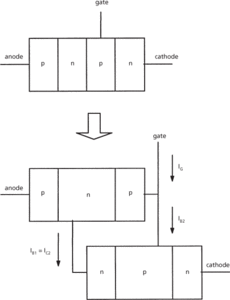A silicon-controlled rectifier whose anode–cathode current is controlled by a signal applied to a third electrode (the gate) in much the same way as in a thyratron valve. It consists usually of a four-layer chip comprising three p−n junctions.
A general term for a family of semiconductor devices that exhibit bistable characteristics: they can be switched between a high-impedance low-current ‘off’ state and a low-impedance high-current ‘on’ state. The thyristor is the solid-state analogue of the thyratron. It is a multilayer semiconductor device with a p-n-p-n structure; this is commonly analysed as a coupled pair of bipolar junction transistors.
The diagram shows a thyristor with one gate contact; this device is usually known as a silicon-controlled rectifier (SCR). In the ‘off’ or forward blocking state, the outer pair of p-n junctions is forward biased but the centre junction is reverse biased, and no current flows between anode and cathode. Injecting a gate current will cause a build up of charge in the bases of the two transistors until the centre junction becomes forward biased; at this point forward breakover or switching to the ‘on’ state occurs. Reducing the forward current below a holding current will switch off the thyristor. The gate-turn-off thyristor (GTO) can be turned on with a forward gate voltage and off with a reverse gate voltage, at any value of anode current. Applications include inverter circuits, chopper, and d.c. switching circuits.
A reverse conducting thyristor (RCT) is a three-terminal multilayer semiconductor device that exhibits similar behaviour to the conventional thyristor in the forward direction, but conducts a large reverse current. Applications include drivers for electroluminescent displays.
The diac (diode a.c. switch) and triac (triode a.c. switch) are bidirectional thyristors, and are useful in a.c. applications. The diac consists of a pair of ungated p-n-p-n structures connected in antiparallel. The electrical characteristics are those of a conventional thyristor (high-impedance ‘off’ state switching to low impedance ‘on’ state at a given breakover voltage), but operating in both forward and reverse directions. The triac is a more complex structure than the basic p-n-p-n thyristor, including additional n-type regions at the gate and anode regions. This enables the triac to switch currents in either direction under control of the gate voltage.

Thyristor with one gate contact: the SCR
- pedogenesis
- pedogeomorphology
- pedology
- pedon
- pedoturbation
- Pedro I (1798–1835)
- Pedro II (1812–91)
- peduncle
- Peebles, James
- peek
- Peekskill meteorite
- Peel, Sir Robert (1788–1850)
- peel technique
- peephole optimization
- peer
- peer to peer
- peer-to-peer network
- peer-to-peer protocol
- Pegasus
- Pegasus rocket
- pegmatite
- pegmatitic
- Peierls instability
- Peirce, Charles Sanders (1839–1914)
- Peirce’s law